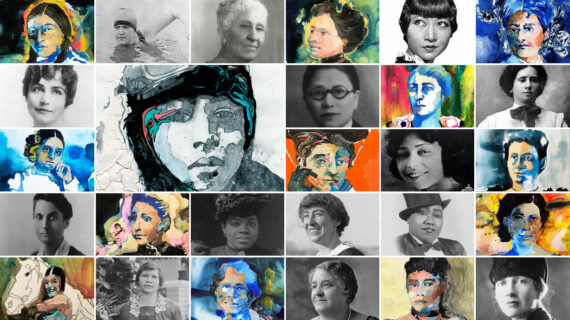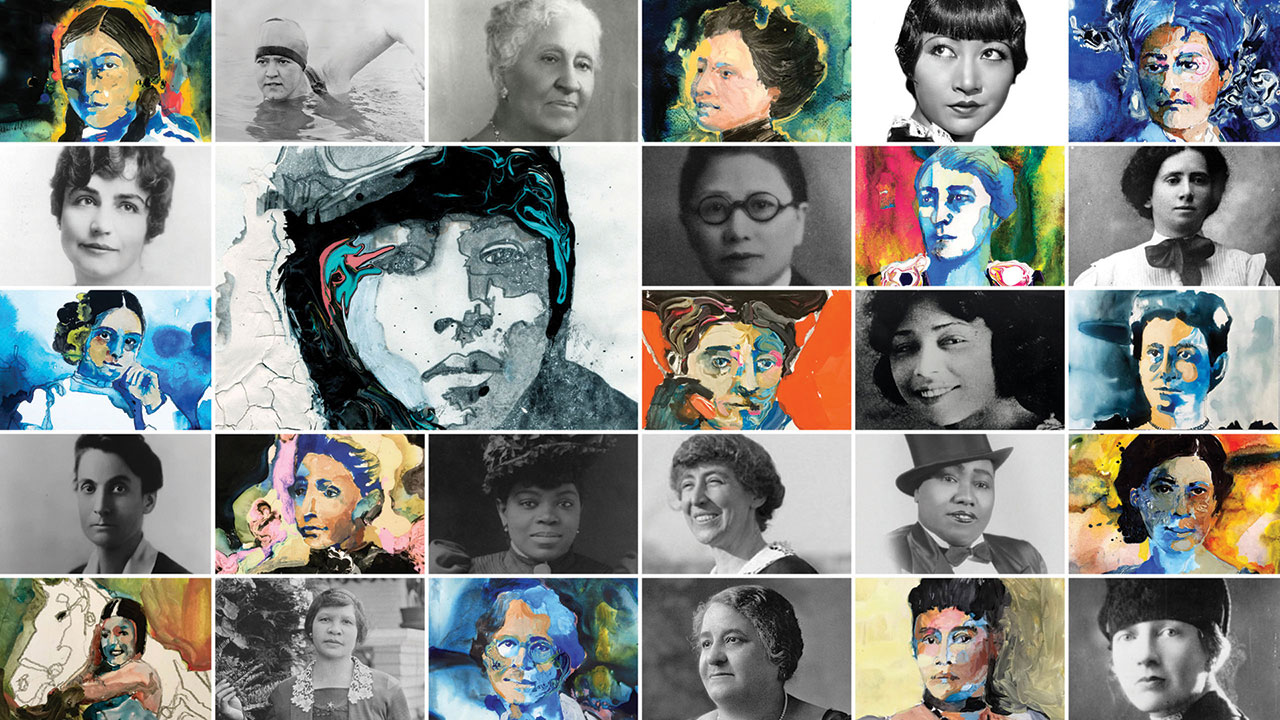– Good evening, everyone.
My name is Molly Dubin, and I’m the curator here at the Jewish Museum Milwaukee.
It is my pleasure to welcome you to this program featuring historian, scholar, and author, Sander Gilman.
Before we begin officially our program, I would like to thank our program sponsors for helping us to bring this important conversation to Milwaukee.
A special thank you to the Nathan and Esther Pelz Holocaust Education Resource Center, and the University of Wisconsin-Milwaukee’s Sam and Helen Stahl Center for Jewish Studies.
Tonight’s lecture is very fitting because when the National Socialists appropriated the term degeneracy or degenerate, they applied it to both artwork and individuals which they deemed inferior in both mental and physical capacities.
That began the process of assigning value to life, and ultimately in the National Socialists’ mind, to identifying those as holding life unworthy of life.
With that, I’d like to introduce our speaker for this evening.
Sander Gilman is a distinguished professor emeritus of the liberal arts and sciences, as well as emeritus professor of psychiatry at Emory University.
A cultural and literary historian, he’s the author or editor of over 100 books.
His focus is on how we see the world, how we shape our senses of ourselves and others.
He’s the author of the basic study of the visual stereotyping of the mentally ill, Seeing the Insane, as well as the standard study of Jewish Self-Hatred, the title of his study.
He’s also the co-editor of Degeneration: The Other Side of Progress.
His most recent book in English is I Know Who Caused COVID-19: Xenophobia and Pandemics.
For 25 years, he was a member of the humanities and medical facilities of Cornell University, where he held the Goldwin Smith Professorship of Human Studies.
He held a distinguished service professorship of the liberal arts in human biology at the University of Chicago for six years, and was a distinguished professor of the liberal arts and medicine for four years at the University of Illinois at Chicago, where he created the humanities laboratory.
He has been a visiting professor at numerous universities in North America, South Africa, the United Kingdom, Germany, Israel, China, and New Zealand.
He was president of the Modern Language Association, and has been awarded a doctor of laws, honoris causa, at the University of Toronto, elected an honorary professor of the Free University in Berlin, an honorary member of the American Psychoanalytic Association, and made a fellow of the American Academy of Arts and Sciences.
And I will note that we cut down this biography extensively, so he is extremely accomplished.
With that, please join me in welcoming Sander Gilman.
[audience applauds] – Thank you very much, and thank you ladies and gentlemen for coming out on this lovely evening when we should be someplace much more pleasant, thinking about much more pleasant thoughts.
I’m gonna be talking about science.
I’m gonna be talking specifically about the biological sciences, and I’m going to be talking about following the science.
We’ve done this now for three years, so you should be expert at it.
Now, we kind of make the assumption that there is a line of demarcation between real science and pseudoscience, between medicine and quackery, but that’s true at any given moment.
What I’m gonna talk about for the next 45 minutes is science, real science, science that was taught at the university, that was augmented within society, and that was unquestioned because if you questioned it, you were not following the science.
Much of which I’m talking about, you will understand today as pseudoscience.
Do understand that the people I’m talking about understood it as real science.
[phone ringing] Such as, for example, the iPhone.
[audience laughs] Now, one of the things that we have to understand about this age of science of the 19th century, the first age of modern science, is that it is highly political.
Rudolf Virchow, one of the most important biological scientists, pathologists of the 19th century, man who created the concept of cellular pathology, and who for decades was a liberal member of Bismarck’s parliament.
In 1848, the year of revolution, wrote, “Medicine as a social science, as the science of human beings, “has the obligation to point out problems “and to attempt their theoretical solution.
“The politician, “the politician who is the practical anthropologist, must find the means for their actual solution.”
And I’m gonna add, for good or for ill.
So we’ll start, of course, with the most important of the scientists of the period I’m talking about, and that is Charles Darwin.
Charles Darwin’s theory of evolution, which is published for the first time in 1859, is quite careful in its claims.
He’s writing this book under pressure.
He’s got a competitor who’s about to bring the same theory out, a man named Alfred Wallace, but he doesn’t want to take too strong a position.
He talks about natural selection, which over “the long course of ages under varying conditions of life,” individuals, organic beings in a severe struggle for life are able, through “the infinite complexity of the relations “of all organic beings to each other “and to their conditions of existence, “which causes an infinite diversity “in structure, constitution, and habits, to be advantageous to them.”
That is, random mutations, some of them positive, most of them neutral or negative, can provide, maybe under certain circumstances on Thursday, an advantage.
Right?
And if it provides an advantage, those individuals have the best chance of being preserved in the struggle for life.
Now, Darwin understood, because remember, Darwin is a geologist.
He’s hired on the Beagle to go around the world, not as their botanist, not as their biologist.
He’s a student of Lyell’s.
He understands that things change over time, sometimes for the better and sometimes for the worse.
Exactly as we’re experiencing now, a mutation that can be positive at one moment may, if the world changes around it, become negative.
So Darwin’s very careful; Darwin’s very, very careful when he talks about natural selection.
His great buddy, the sociologist and philosopher Herbert Spencer, in 1864, reduces it to a catch word, an advertising jingle.
He talks about the “survival of the fittest,” a phrase Darwin never uses.
“The survival of the fittest,” he writes, “which I have here sought to express in mechanical terms, “is that which Mr. Darwin has called natural selection, “or the preservation of favored races in the struggle for life.”
Now, races has two meanings, meaning a cohort group, just a collection of; we can have a race of whales.
But it also has a second meaning, which in the science of the time means the races of man, right?
Now, in the back of Spencer’s mind, not necessarily Darwin’s, is Thomas Hobbes, who 150 years early said, and you remember this from college, that the life of man’s solitary, poor, nasty, brutish, and short.
So maybe the survival of the fittest means that what?
The best survive.
The best survive.
Thomas Hobbes’s answer, by the way, is good government.
Herbert Spencer’s answer is biology.
Now, both of these guys are arguing with the French biologists of the beginning of the 19th century, Lamarck, who very specifically describes how organisms change.
And he says that “a more frequent and continuous use “of any organ gradually strengthens, “develops, enlarges that organ, and gives it a power “proportional to the length of time it has been so used.”
So if I’ve got a muscle and I pump iron every day, I’m gonna have this strong muscle.
And “all of these are preserved “by the new individuals which arise, “provided that the acquired modifications “are common to both sexes or at least to the individuals who produce the young.”
And as an example, very famous example, of course, is the giraffe.
Giraffe starts with a tiny neck, leaves are up in the tree, neck gets longer, longer, longer, right?
Not ambiguous.
Now Darwin was saying maybe, sometimes, some mutations.
So what he’s doing is he’s correcting Lamarck.
Lamarck says an individual develops something that enables them to function better in the world that gets passed down inevitably.
Now, the reality, of course, is that what Darwin is talking about in natural selection, what is in the background of all of these discussions in the 19th century is not natural selection in and of itself, but natural selection in contrast to an artificial selection or selective breeding.
Both of these have as their ancestor, our friend, the wolf.
Right?
Now, Darwin makes a case that people are different than animals and plants.
You don’t expect that from Darwin; Darwin makes the case.
He makes an argument in 1868, right, that human reproduction is natural, or is it artificial?
Is it exogeny, marriage outside of the group, or is it endogeny?
Because the big debate, debated in the halls of Parliament, is who can you marry?
Who can you reproduce with to make what?
Healthy children.
And why do you want healthy children?
Because they will have healthy children.
Maybe if you’re Lamarckian, right?
So he argues in 1868 that “men during primeval times “may have had been more excited by strange females than those with whom they habitually lived.”
He doubted that “consanguineous marriages,” marriages within the group, endogenous marriages “such as they are permitted in civilized civilizations,” here in Britain, right, “would not be considered as close interbreeding as in the case of our domesticated animals,” and they would not cause any injury.
So now we’re starting to think of these, well, maybe there’s an argument about people that is kind of different than the argument about organisms.
Now, Darwin’s proof is offered by his son, George Darwin, who is one of the first generation of statisticians.
Because one of the things that makes science science at the end of the 19th century is statistical reasoning.
Statistics gets introduced, we can now talk about collectives, groups, and we can talk about the groups in terms of proportion.
Now, George is a quite distinguished statistician.
His work is widely circulated in Germany, and he argues against, I will stress this, against the increased rate of mental illness among certain families because of the marriage of cousins.
But he pointed out the increased rates of certain diseases, including mental illness, among the British inbred aristocracy, which we saw on display last weekend.
[audience laughs] Oh, you realize what I read?
Okay.
He also localized the increase of mental illness in urban areas, East End of London, among the poor and the immigrants.
So people are different because they make selections in whom they reproduce with, selective breeding.
Well, Darwin is married to Emma Wedgwood, Wedgwood of the famous pottery family, right?
His wife was also his first cousin.
Now there’s a debate, as I said, in Parliament about permitting first cousins to marry.
The debate never turns into law.
Out of Darwinian evolution comes eugenics.
This is a wonderful logo.
It’s the logo of the second International Eugenics Conference of 1921, and you can read that eugenics is the self direction, so what we’ve been talking about, of human evolution.
And he says it’s like a tree, it comes from genetics and biology and anatomy and statistics, right?
The person who coins this term, eugenics, is Francis Galton, who like, by the way, George Darwin, is of that first generation of statisticians.
He develops the statistical concepts of regression and correlation, which I still don’t understand.
A year after Darwin’s death in 1883, he gave his research on human selection a name: eugenics.
Now, I will point out to you that Galton was Darwin’s half cousin, sharing a grandfather, the famed naturalist Erasmus Darwin.
Now, Galtonian eugenics, the self-direction of human change, is divided into two parts, very mechanical.
There’s positive eugenics.
Here’s my certificate.
It says that I have a perfect physical and mental balance and unusually strong eugenic love, and therefore I am going to further the race.
That’s my card, by the way.
[audience laughs] But we also have negative eugenics, right?
Only healthy seed must be sown.
And by the way, the agricultural metaphors here are not accidental.
We’re talking again about the sort of breeding we’re talking about with domestic animals.
Check the seeds of hereditary disease and unfitness by eugenics.
So you either marry good people together to get better kids, or you stop bad people from reproducing, so you get rid of them.
But there’s always an out, there’s always a footnote, always a footnote.
And the footnote is gym.
I hate gym.
[audience laughs] I was always the last one chosen for every team.
[audience laughs] Right?
So is it possible to take inferiors, right, the people who normally you wouldn’t let reproduce, and make them into maybe not as good as you, but almost kind of, maybe?
And how do you do it?
Well, Lillian Curtis Drew, in 1923, she was at the Central School for Physical Education in New York, said, the object of gymnastics “is to establish in the individual “such powers of motor control “as will make the erect carriage a permanent habit, “an integral part of the individual “rather than a static position to be assumed in the gymnasium “and associated only with this environment, “or to be taken on the admonition to stand up straight.
To be of any real function, it must function in life.”
In other words, you can maybe almost kind of remake their bodies to look almost normal.
Almost normal, maybe almost normal.
Who’s she talking about?
She’s talking about the Italians and the Jews in the Lower East Side of New York.
Now, Francis Galton’s successor as president of the International Eugenics Society is Leonard Darwin.
Leonard Darwin, in 1929, writes a little book called What Is Eugenics?
And he begins, of course, with a chapter on breeding domestic animals.
He wants then to eliminate the unfit, people suffering from epilepsy to tuberculosis.
He wants to sterilize the feeble-minded and he wants to sterilize the contingent criminality.
Right?
He wants to have family planning, he wants to have contraception, but he also wants to have advantageous marriages.
He’s in favor of cousins marrying unless the stock common to both parents is bad.
But he says, we are shocked to read, that if both parents come from good stock, like me, their children have a eugenic double advantage.
Now, this is all real science.
And I began by saying that that term race, which means both cohort group, also speaks of the race of man.
Because the races of man are part and parcel of 19th and early 20th century science.
Race science in medicine and in biology is real.
It exists in the world.
In the course of the 19th century, science becomes both neutral and global.
You believe that true today.
In fact, it is neither neutral nor global.
And why is it neutral and global?
Because it comes to replace Paul’s notion of religion as the touchstone for notions of truth.
And that the biology of race, race difference, stands at the center of the 19th century science of man, which would include biology, medicine, anthropology, sociology.
And anyone who thought of himself as a scientist, and virtually all of these people are men, by the way, during this period, would not have been able to avoid confronting race science.
And those male scientists such as African Americans and Jews who were labeled as different, usually as inferior within race science had to come to terms with the fact that the arena of endeavor which gave them status as neutral, objective scientists also demanded that they acknowledge, and in very few cases, refute their inherent biological inferiority.
And how was that inferiority defined?
It was defined in terms of degeneration, the other side of progress.
Now, the term degeneration is, if not coined, made most popular by the Viennese-born Parisian physician Benedict Augustin Morel in 1857.
This is a slide from his handbook, and he defines degeneration as morbid deviation from the norm.
And he defines himself, of course, as the norm.
I love this slide; I use it in class all the time.
This is Morel at his best.
These are cretins, imbeciles, deaf-mutes in rural villages in Switzerland, which in point of fact in the 19th century, had a large percentage of people with mental disabilities and physical disabilities.
His argument is this is caused by inbreeding, endogeny, caused and perpetuated by heredity.
That, by the way, is Morel, and these are our two cretins.
So I always ask my students, “Look at the picture, look at the picture, look at the picture.”
And I say, “Well, what do you find?”
And there’s always, well, some student raised their hand and said, “That guy looks like Arnold Schwarzenegger.”
[audience laughs] I said, “Yeah, he’s got something you don’t know about.
He’s got a goiter.”
Because in 1811, iodine was discovered, and in 1838, a long time before Morel, it was discovered that the absence of iodine, such as in small, rural villages in Switzerland, caused what?
Hypothyroidism, with all of these horrible side effects.
Nobody in this room has that problem because in 1924, the federal government mandated, right, way before Dr. Strangelove and fluorine in the water supply, that table salt be augmented with iodine.
So none of my students have ever seen Arnold Schwarzenegger before.
Right?
Now, what is important is that Morel’s notion doesn’t follow the science, doesn’t follow the science.
It becomes a way of thinking about biological difference, visible difference.
Morel’s greatest popularizer was Max Nordau, second president of the Zionist Organization, probably the most important Zionist after Herzl in the first generation of Zionism.
His book, Degeneration, translated into about 26 languages, including Ladino, the language of Mediterranean Jews, kind of augments Morel.
Degeneration is “a morbid deviation from an original type.
“This deviation, even if at the outset, “is ever so slightly contained, “transmissible elements of such a nature “that anyone bearing in him the germs “becomes more and more incapable of fulfilling his functions in the world.”
Fit what?
For civilization, a concept that Sigmund Freud detested.
Civilization, functioning in the world.
“And mental progress finds itself menaced in his descendants.”
Now, eugenics and degeneration theory is not merely a theory of the right or the left.
It is not merely a theory of Morel, but also of Jews like Max Nordau, and the most important African-American thinker of the period, W.E.B.
Du Bois.
He wants to breed a better Negro race.
He says “the Negro race, like all other races, “is going to be saved by exceptional men.
“African-Americans must learn that among human races and groups, as among vegetables…” These analogies are really interesting.
“As among vegetables, quality and not merely quantity really counts.”
He’s as much a eugenicist as Nordau was a eugenicist.
Now, remember Virchow and the notion that the scientist has the theory, and the politician makes the theory in the world.
Well, the person who makes the theory in the world, most importantly in the 1920s, is Harry Laughlin, who is the director of the Eugenics Record Office of the Carnegie Institute.
And he proposes mass sterilization in 1922 in a book called Eugenical Sterilization in the United States.
And here are the people he wants to have sterilized.
I want you to pay attention to the list to see if you’re on it.
[audience laughs] The feeble-minded, the insane, criminals, epileptics, alcoholics, blind persons, deaf persons, deformed persons, and poor people.
Oh, Harry Laughlin was on the list; he had epilepsy.
Eugenic laws are introduced well before Laughlin.
Indiana, by the way, the state that has more members of the Ku Klux Klan than any other state in the United States, has one already in 1908, compulsory sterilization.
But the Virginia statute is really important because Laughlin is really important.
And it eventually, the law which is drafted by Laughlin in 1924, comes before the United States Supreme Court in a case called Buck v. Bell, which is decided on May the 2nd 1927, by a vote of eight to one; it’s upheld.
The Bucks, Carrie and Emma, both institutionalized, both institutionalized because each has had an illegitimate child, are white.
And that’s really important in the 1920s because the majority of people who are forcibly sterilized in the United States, 80,000 over the next decades, are African Americans.
By the way, the last state to get rid of forced sterilization is the state of Oregon in 1980.
Do remember that Oregon has in its constitution that it is an all-white state and that no African Americans would be permitted to settle there.
Now, the majority opinion of the Supreme Court is written by, I’m gonna make a claim, the person I think is probably the smartest person ever to serve on the Supreme Court, Oliver Wendell Holmes, Jr. Not, by the way, the most ethical, not, by the way, the nicest.
And here’s what he writes in 1927.
“We have seen more than once that the public welfare may call upon the best citizens for their lives.”
World War I has just happened, a whole generation of the best and the brightest young men have been murdered in France.
“It would be strange if we could not call upon those “who already sap the strength of the State “for these lesser sacrifices, “often not felt to be such by those concerned, in order to prevent our being swamped with incompetence.”
This is Max Nordau, right?
“It is better for all the world if instead of waiting “to execute degenerate offspring for crime, “or to let them starve for their imbecility, “society can prevent those who are manifestly unfit from continuing their kind.”
And this is something we heard a lot of over the last three years.
“The principle that sustains compulsory vaccination is broad enough to cover cutting the fallopian tubes.”
And then this is perhaps the phrase that everybody knows from Buck v. Bell, “Three generations of imbeciles are enough.”
Now, Harry Laughlin’s law in the Commonwealth of Virginia is ever so slightly rewritten when the Nazis take over in January 1933, as the Law for the Protection Against Genetically Defective Offspring.
And the law, which is in point of fact, by the way, American eugenics law, becomes German eugenics law, provided the legal basis for sterilizations.
In 1934 alone, the Germans sterilized about 80,000 persons without their consent.
By 1939, sterilization, which, by the way, continues through to 1945, morphs into euthanasia, into T4, into the murder of people who are declared unfit.
Who, and again, I’m quoting Nordau, who sap what the strengths in the economy of the nation, who do not add to the nation.
What is really important for us to understand is that this is not equal opportunity sterilization, not equal opportunity euthanasia.
Henry Friedlander, about 30 years ago in an incredibly important book, pointed out that both for sterilization and for euthanasia, the first people sterilized and the first people murdered at asylums like Hadamar, were Jews.
So this is not equal opportunity.
Now, the case study, surprise, surprise, for this evening are the Jews, the end of the 19th and the beginning of the 20th century.
So let us start with our old friend, Charles Darwin’s cousin, Francis Galton, who in 1910 offers an interview to The Jewish Chronicle of London and finds admirable the hygienic regulations of the Mosaic code, which contributes to the fitness of the Jewish race.
Ritual slaughter, the circumcision, not eating pork.
He also likes the fact that Jews have lots of kids, that they enjoy in the multiplication of the human species.
But, but for him, the most important thing, 1910, right before he dies, it is still more important to determine that children shall be born from the fit and not the unfit.
Let’s go back a little bit; let’s go back to 1885.
Herbert Spencer.
You remember Herbert Spencer, survival of the fittest, great buddy of Darwin, great buddy of Galton, belonged to the same clubs, suggested to Galton that, you know, there’s this new invention called photography.
By the 1880s, it’s 40 years old.
He says, “I bet you if you take a whole bunch “of photographs of people in asylums, “if you take a whole bunch of people in prison, “and you overlap them, multiple exposures, “take 10 negatives and overlap them, you’ll get a type.
“You’ll get the essence of what a person in the asylum, a person the criminal is.”
Galton says, “Damn, that’s a good idea.”
[audience laughs] Calls up the principal of the Jewish School in the East End of London and says, “I’m coming with my photographer on Monday.
I want to take photographs of your students.”
Now you can see the principal panicking, right, you just see.
Holy mackerel, Charles Darwin’s cousin, Francis Galton, is coming to school.
Says to the kids, “Hey, look, you wash your faces, you put on a tie, you be on your best behavior.”
Galton comes with his camera, takes a whole bunch of photographs, whole bunch of photographs, goes back to his lab, superimposes them one upon the other and gets types.
And gets what he describes them, these are all quotes of Darwin, as the typical features of the modern Jewish face.
And what does he see?
He sees the cold, scanning gaze of the Jew.
“There was no sign of diffidence in any of their looks “nor of surprise at the unwanted intrusion.
“I felt rightly or wrongly that every one of them “was coolly appraising me at market value [audience laughs] without the slightest interest of any other kind.”
Because everybody could see the degeneracy of the Jews.
Georg Burgl, in his handbook of forensic medicine, 1912, sees the degenerate nature of the Jew marked by “physical signs of degeneration “such as asymmetry and malocclusion of the skull, malocclusion of the teeth.”
The images from 1904, we see here the large, protruding ears of the Jew, a sign of their inferiority, we see the eyes that reduces everything, what?
To the mercantile value.
We see the hand, that grasping hand of the Jew, the flat foot of the Jew, which means that they cannot become soldiers and therefore not become citizens.
And of course, the nose of the Jew.
Someone asked me many years ago whether or not there was a Jewish nose.
And I answered, and I will repeat that this evening, I have known in my career, long career, maybe 100,000 Jews, and every single one of them had a nose.
[audience laughs] But why are the Jews degenerate?
But why are the Jews degenerate?
Perhaps the most important psychiatrist of the day, Emil Kraepelin, the man who in a sense is the father of modern organic psychiatry and founder of the Institute of Psychiatry, which still exists in Munich, speaks with authority about the domestication of the Jews, Jews getting integrated in civilization, their early isolation from nature, and their exposure to the stresses of modern life, civilization.
And again, remember what Max Nordau, the great Zionist says: The degenerate cannot function within modernity, within civilization.
But how does that work?
Well, the Jews are an incestuous people.
They’re an endogenous people.
Wilhelm Erb commented about the increased nervousness among the “Semites, who already are a neurotically predisposed race.”
That’s true, by the way.
[audience laughs] “Their untamed desire for profit and their nervousness, “caused by centuries of imposed lifestyle “as well as their inbreeding and marriage within family, predisposes them to nervousness.”
Okay.
So now, if we were real eugenicists, we would say, “Sterilize them all,” right?
But remember, we have an off-ramp.
Remember the off-ramp?
Gym.
[audience laughs] Thomas Mann in 1907, future Nobel Prize winner, non-Jew, by the way, in an essay called “Solving the Jewish Question” says, in his own generation, he has seen the ghetto Jew with his “hump back, crooked leg, and red, gesticulating hands” being replaced by “young people “who have grown up with English sports “and all of the advantage without denying their type and with a degree of physical improvements.”
They’re almost like us; they’re almost normal.
They kind of look okay because they went to gym.
[audience laughing] Now, Theodor Herzl is very much of the same mind.
Herzl says, how can we get rid of the ghetto Jew?
How can we create a new Jew for a new land?
He says, “Education can only be achieved “through shock treatment.
“Darwin’s theory of imitation will be validated.
The Jews will adapt.”
They will adapt.
“They’re like seals that have been thrown back in the water “by an accident of nature.
“If they return to dry land and manage to stay there “for a few generations, their fins will change back into legs.”
This is pure Lamarck; this is the giraffe’s neck.
That’s how you make new Jews: you grow them like giraffes.
Now, Max Nordau, in 1903, addressing the Zionist Conference, says you do it through sport.
He says, “We must again think of creating “a Jewry of muscle once again!
“For history is our witness that such a Jewry once existed.
There is no shame to admitting this.”
That it exists in the past, we’ve lost it, we went into the water, we developed fins.
Now we gotta come back on the land and we gotta get legs.
“Our new muscle Jews have not yet regained the heroism “of their fathers.
But morally speaking, we’re better off,” this is pure Thomas Mann, by the way, “today than yesterday, “for the old Jewish circus performers of yore “were ashamed of their Judaism and sought, by the way of a surgical pinch,” decircumcision by the way, “to hide the sign of their religious affiliation.
“While today, the members of our Kochba sports club proudly and freely proclaim their Jewishness.”
But, and here’s a question that I asked every single day during gym period, are sports really Jewish?
[audience laughs] When the philosopher, Jewish philosopher and educator Franz Rosenzweig, visited one of the Maccabi Deutschland sports clubs founded in 1903.
This is, by the way, Rosenzweig in the First World War in uniform.
He noted that while at the sports club, there were signs in Hebrew on the wall stating “mens sana in corpore sano,” juveniles’ line, right?
A sound mind and a sound body.
The young men there, even though they were really good and well-trained, seemed to do nothing about religious belief or practice.
So during World War I, and you see how this all comes together, the rise of Zionism, the First World War, becoming new men on the frontier, on the front.
The new Jew on the front, trained now for physical fitness, “exposed as lies the fairytale of the bent and crooked Jews “as our youth grows to maturity in good health and with straight bodies.”
Bodily training, gym, serving in the army, undertaken to refute the calumnies of the degeneration of the Jews, has become leitmotif of Jewish reaction to anti-Semitism.
Not merely rejecting anti-Semitism is sufficient.
The Jewish body must be like what?
The ideal norm, not the degenerate, not the morbid deviation from the norm, to refute such claims.
And it works.
Well, at least in the movies.
[audience laughs] Or at least Ari Ben Canaan, Paul Newman, who at least is Jewish on his father’s side, has the perfect body; he’s gorgeous, by the way.
I’m sorry, he’s just gorgeous.
In Exodus, in the film.
My friend Miriam Rurup, the historian, writes that “physical labor “became part of a Jewish body politics “with regard to the Zionist citizen-to-be.
“The target group, the Zionists, address with their call for productive, physical labor.”
How do you prove that you’re not degenerate?
You have productive, physical labor, right?
Not doctors and lawyers, farmers and shepherds.
“Was not so much non-Jewish society, “and even less the anti-Semites, “but rather religious Jews who stuck to their books “and religious practices.
“In quite condescending manner, “they used to call them ‘ghetto Jews,’ “in contrast to the new ‘Halutz,’ the pioneer, who had yet to be trained.”
Now, I’ve been talking about the late 19th and early 20th century.
Every single one of these themes, without exception, has reappeared within white nationalism and white Christian nationalism.
And I’m not gonna just say in the United States because it’s true in Great Britain, it’s true in Germany, it’s true throughout Eastern Europe, throughout Poland and Hungary.
The idea that you can breed better people, that the Jews, by definition, if you look hard enough, aren’t quite as normal as they make out to be.
That in point of fact, what we can do from generation to generation is to breed better, more normal in the sense that they define normal human beings.
We live in an age in which the ambiguity of evolution is being replaced by the politics of a certainty of change.
Now, this may well be an anomaly.
This may well be an off-ramp because after the Holocaust, everything that I talked about became taboo.
Eugenics was thrown out with the bath water.
As I said, it took until 1980 in Oregon, but eventually, all of the sterilization laws were gotten rid of.
Race Science disappeared only to reappear early on within genetic arguments about genetic cohorts, quickly replacing the word race, because people like myself said you can’t use that word anymore, with other terms like ethnic cohort.
But maybe not.
Maybe what we’re looking at is a desire to have some control over the world.
And following the science may well mean interpreting the science in ways that you find politically opportune and politically useful.
I began with Virchow’s talk about the difference between the scientists and the politician, and I ended it with the warning that the claim that the politician put science into practice can be very problematic.
And I leave you with that problem to wrestle with.
I thank you for your attention.
[audience applauds]
Search University Place Episodes
Related Stories from PBS Wisconsin's Blog

Donate to sign up. Activate and sign in to Passport. It's that easy to help PBS Wisconsin serve your community through media that educates, inspires, and entertains.
Make your membership gift today
Only for new users: Activate Passport using your code or email address
Already a member?
Look up my account
Need some help? Go to FAQ or visit PBS Passport Help
Need help accessing PBS Wisconsin anywhere?

Online Access | Platform & Device Access | Cable or Satellite Access | Over-The-Air Access
Visit Access Guide
Need help accessing PBS Wisconsin anywhere?

Visit Our
Live TV Access Guide
Online AccessPlatform & Device Access
Cable or Satellite Access
Over-The-Air Access
Visit Access Guide
 Passport
Passport












Follow Us